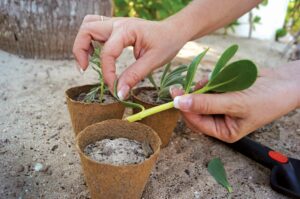Your garden on the beach
Create inyour beach house a space with a nice environment full of greenery, where you can enjoy the coast and protect it for future generations.
What are the benefits that a garden on the beach provides?
The seaside landscape creates in us a feeling of rest, both physical and emotional, when we associate ourselves with this fragile and ever-changing ecosystem.
The coast, a place where we interact with different ecosystems and living beings, discovers in us mental and physical health.
Among other benefits, is known to decrease blood pressure and. muscle tension.
Likewise, having green area in front of the sea helps prevent beach erosion, it creates a protective barrier, intercepts the movement of sand and wind with the accumulation of organic matter and forms new ground areas.
This article presents the method of transplanting native plants on the coast as the most effective and easy to perform. The method is explained below, just as the cares it needs.

Photography: Ana María Icaza
How to propagate plant species of the dune?
To transplant native species on the coast is not only the easiest and most accessible method, but also benefits the conservation of the native species of the coast.
Transplantation, as the name implies, is the transfer of plants from one place where plants are rooted to another.
The dune or the coastal ecosystem is made up of mounds of sand with vegetation; they have different microenvironments, which depend on the winds and tides to which they are exposed.
Dune vegetation is considered halophytic (salt plants) for they grow in soil with a high content of soluble salts.
Depending on the plant specie and the distinctive properties is the type of substrate and the position on the dune you will need.

Which plants can I transplant?
Cactus or succulents are easier to reproduce with this procedure, while the bushes and trees are more difficult from cuttings.
The species found in front of the coast, meaning closer to the sea, are the herbaceous and are known as pioneers; they practically grow in mobile sand.
Among the most common are the Suriana Marítima, the Atriplex Canescensand Sesuvium Portulacastrum.
Shrubby scrublandsare plants that develop inside the dune, where the substrate has more organic matter. The most common are the Bravaisia Berlandierianaand the Ipomoea pes-capra,plant that is known to have a medicinal value to cure kidney diseases.

Photography: Ana María Icaza
How is the cutting method used to reproduce plants?
You will need the following materials:
- Pruning shears
- Soil or compost substrate
- Sifted sand sea
- Rooting Compound, a dilute mixture of organic fertilizer or honey.

Photography: Ana María Icaza
SPECIAL CARES
Keep the soil around the transplant free of weeds.
The spread of plant species in the dune will be better if they are protected from excessive coast wind and with daily watering.
It is recommended to do this reproduction in early spring or summer, especially in the period of the new moon, which is beneficial for root development.
Usually after two or three months you can know if the transplant was successful, depending on the type of plant.

Photography: Ana María Icaza
¿HOW TO PLANT CUTTINGS?
Stir the earth or substrate with sand at a ratio of 50%. Place this mixture in seedbeds without squashing, it is important to oxygenate.

Photography: Ana María Icaza
Choose the plant you want to transplant and with the pruning scissors cut the plant at a angle of 30 degrees and at a distance of 15 to 20 cm, is better if the plant has one or more knots.

Photography: Ana María Icaza
Remove the leaves from the bottom leaving a distance of 5 to 10 cm, remove the flower buds if it has. Is better if the cut is made below a knot, because the roots will grow from that part.

Photography: Ana María Icaza
Make a mixture of water and root enhancer, fertilizer or a drop of honey and cover the end of the plant cutting.

Photography: Ana María Icaza
Make a small hole in the ground and bury the cutting. Avoid exposing the plant to direct sunlight, UV rays are harmful to the roots.

Photography: Ana María Icaza
Water thoroughly when they are newly planted.
Do not be discouraged if you see that they have wilted at first, it is normal.
Cover them with a plastic bag, it helps to maintain the proper moisture, give them a gentle tug, if there is resistance it means that it has begun no from the root and is growing. This could be the ideal time to switch to the chosen location.

Photography: Ana María Icaza
Transplant the plants to the place where you want them to grow, consider their average size and protect them from the winds that whip the coast with dried palm leaves.
Reference: Rafael Durán García, Martha Méndez González
y Roger Orellana Lanza. Manual de propagación de plantas nativas de
la península de Yucatán. Vol. I.2a ed. (Mérida: Centro de Investigación Científica de Yucatán, A.C., Secretaría de Ecología del Gobierno del Estado de Yucatán, Programa de Naciones Unidas para el Desarrollo, 2007).








